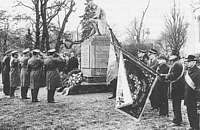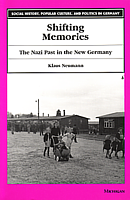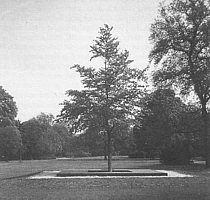One of the darkest moments in modern history is the bureaucratic genocidal
murder of different people during Nazi Germany’s attempt at European domination.
This period, better known as the Holocaust, has been widely studied and
debated throughout the post war period. For historians and common people
alike, it is arduous to comprehend the magnitude of this event in the
context of modern history. The Holocaust has left a defining imprint on
civilization, but more profoundly on German history. Due to the importance
of the Holocaust when discussing Germany, historians are now making an
effort to analyze how Germans view the events of World War II. In his
book Klaus Neumann tries to give an understanding of this issue.
One can make the argument that when Germans were confronted with the
atrocities committed under the name of Germany in the years directly following
the end World War II, there was a permeating desire to distance themselves
from those they considered to be sadistic Germans. The Holocaust is a
shameful event that was committed under the name of Germany. Due to these
facts, it is easy to infer that people did not want to remember that period,
and it would be easier to see the self as the victim and not the victimizer.
However, as time passed it became easier to come to terms with such shameful
events, although it would be false to say that all Germans have come to
terms with their Nazi past. Memorializing the past serves the purpose
of showing Germany in a brighter light to the outside world. That is why
politicians become worried when a memorial is desecrated, and why they
are more concerned with the reputation of their town.
Klaus Neumann states that there was a period when German towns were in
search of their history and the memorialization of the past began to take
form. The way in which the Germans decided to remember their Nazi past
was through the creation of memorials honoring those who perished under
the Nazi regime. Memorials played a major role in the 1980’s and through
the 90’s. During this decade it seemed that a wider percentage of people
were coming to terms with their Nazi past. There is a gradual progression
from 1945 to the present day. The evolution of emotions and sentiments
regarding the Holocaust by Germans has changed dramatically. At the end
of the war Germans perceived themselves as the victims and gradually came
to terms with their status as victimizers, to a certain extent. This gradual
progression is portrayed by the towns of Salzgitter, Celle, Hildesheim,
Weimar and Furstenberg. Young Germans now believe they should not be held
responsible for the cruelties committed by past generations or the need
to be reminded constantly. They argue that they had nothing to do with
Nazi atrocities.
Germans directly after the end of the war felt as is they were the victims.
Neumann states, "Such attitudes are not merely a local phenomenon,
but resonate with national discourses about Germans being the quintessential
victims in the twentieth century" (195). Many Germans distanced themselves
from the role of victimizers and responsibility by portraying and assuming
the role of the victim. Neumann quotes Hannah Arendt by stating, "This
apparent heartlessness is only the most conspicuous outward symptom of
a deep-rooted, stubborn, and at times vicious refusal to face and come
to terms with what really happened…Such an escape from reality is also,
of course, an escape from responsibility" (49).
The Germans who perceived themselves as victims emphasized that that
they were taken advantage of by different groups. These groups included
the SS, the western powers and the displaced people. In the town of Celle
Neumann affirmed, "Rather than thinking of themselves as victimizers,
people in and around Celle soon remembered April 1945 as a time when they
had become victims—first targeted by Allied bombers, and then harassed
by former forced laborers and by prisoners liberated at Bergen-Belsen"
(53). Similarly the citizens of the city of Weimar saw themselves as the
victims in the aftermath of the war. They thought they had been victimized
by the SS, the Russians and the Americans who made them suffer by forcing
them to visit Buchenwald. The citizens of Salzgitter as well saw themselves
being victimized by the Allies who were dismantling their complexes, "The
history of Allied dismantling was suitable in yet another respect. It
could be used to recast Salzgitter from being a city where massive crimes
had been perpetrated against concentration camp prisoners and non-German
workers, to one that had suffered and whose residents could now identify
as victims" (26).
The ideology of seeing themselves as the victims gradually receded and
eventually the younger German generation of citizens came to terms with
their Nazi past. Today, there is however another surging belief among
Germans. A small German minority feel that they should not be constantly
reminded about Nazi atrocities during WWII. Neumann discusses how different
Germans view street names dedicated to Holocaust victims. There are twenty
streets named after children that were used for experiments and at the
closing of the war were murdered. Some residents did not agree with the
naming of the schools after the children. "..I am a person in favor
of memories happening. But it must not be imposed on people… One can’t
be reminded of it all the time. That then also provokes aggression…"
(247). They argue that they are constantly reminded, and that aggravates
people and further strengthens what Daniel Goldhagen termed ‘the ordinary
German.’ "I don’t want to always to be addressed as a German, but
as a human being…" (248). This conjures a valid point, that being
should Germans still carry the burden of the Holocaust. There are other
atrocities committed by other governments under the cloak of the nation;
however it seems that Germany is the sole country singled out and forced
to shoulder the burden of atrocities. A citizen from Burgwedel states,
"Our generation has actually not nothing to do with it, but we are
now being burdened with it here" (249).
German perceptions dealing with their Nazi past and how they changed
are better represented by the towns of Salzgitter and Celle. Salzgitter
was home the home of Neuengamme Concentration Camp; the camp had three
satellite camps, Salzgitter-Bad, Watenstedt/Leinde and Drutte. Those in
the camps were used by the Reichswerke Company. Those who lost their lives
were buried at Jammertal. The death toll is a few thousand. Once research
on the city began, some argued that the city and the company benefited
from forced labor coming from the Neuengamme satellites. Many opposed
the interpretation of the past; the company vehemently rejected what researchers
were stating. "It was not until Salzgitter’s fortieth anniversary
in 1982 that a sizable number of its citizens began to view the past of
their city in a profoundly different way" (Neumann 31). In 1982 local
institutions such as the Protestant Evangeliche Erwachsenenbildung offered
a series of public lectures and panel discussions regarding different
aspects of the topic, "Salzgitter in the National Socialist Period"
(31). After much debate memorials were constructed to honor those who
died in Neuengamme Concentration Camp. By 1992 there was a more open atmosphere
concerning Salzgitter’s Nazi past. "Celebrations in 1992 were markedly
different from those in 1982. Salzgitter now publicly identified as a
city conceived and born in Nazi Germany, whose growth was linked to the
labor of concentration camp prisoners" (39).
 |
Veterans celebrating Volkstrauertag (Day
of Mourning) in Celle, 1966.
The text visible on the flag says "...and its hunters."
|
The same phenomenon of a change in the 1980s can be observed in Celle.
As the war reached its culmination concentration camp prisoners were evacuated
from their camps and transported to Germany, away from the advancing Russian
army in the East and the American army from the West. On 8 April 1945
a train carrying approximately four thousand prisoners was parked next
a train carrying ammunition. That day American bombers attacked Celle’s
rail facilities. Both, trains were hit, and half the prisoners perished
in the attack. Those who survived the bombing escaped into the woods.
Members of the SS, SA, police and army were used as a collective force
to recapture the escapees. This collective force engaged in what was later
termed ‘Celler Hasenjagd’ or the rabbit hunt of air raid survivors. The
Hasenjagd extended until April 10. Neumann states that the Hasenjagd vanished
from public memory by the end of 1948. "…there was seemingly no need
to forget or remember the Nazi years—as if they were yet to happen. Between
the late 1940s and early 1980s, the town largely sealed itself off from
public debates about issues of remembrance and forgetting—not by rejecting
them but by pretending that they could not even be imagined" (56).
Starting in the 1980s there were numerous public commemorations that
allowed discussions of the past. In addition, in the mid-1980s Celle wanted
to show itself as a modern town. For their anniversary in 1992, the slogan
chosen was ‘Celle 700 Years Young’. "In order to appear young, Celle
had to shed its image of being a leftover from Nazi Germany, so it, too,
had to acknowledge its Nazi past" (60). There were several memorials
dedicated to those who died in Celle. Honoring those who died in the Hasenjagd
was the Johnny Lucius memorial. Johnny Lucius was a designer whose idea
of a memorial was chosen by a committee in Celle in remembrance of those
who died.
The Germans who are doing the memorialization are church organizations,
local politicians and those who can be characterized as the children and
grandchildren of those who were a part of Germany during the Nazi reign.
The later German generations have become interested in the Nazi past.
Both, Salzgitter and Celle exemplify this by the manner in which their
citizens and local civic leaders are acknowledging the Nazi past. As conservative
leaders are replaced by those who identify with the left more students
and local citizens began to question the town’s interpretations of history.
Most people now acknowledge the Nazi past are those who identify with
the left.
In the town of Celle, like Salzgitter students began to research the
past, the ceremonies held afterwards in honor of those who died were done
by leftist citizens. "On June 1983, at the Waldfriedhof cemetery,
the dead of April 1945 were commemorated publicly in a ceremony organized
by a loose alliance of leftists associated with the trade union movement"
(Neumann 58). In the town coalitions were formed among Lutheran pastors,
left-wing social democrats and communists opposing those who symbolize
the Nazi Regime. The coalition in the town of Celle was against the mayor
who was a former member of the SS. Like many other conservative leaders,
the mayor of Celle did not acknowledge the Nazi past.
The civic leaders who acknowledge their towns’ Nazi past seem to do it
because they do not want their towns to be considered Ewiggestrige,
described by Neumann as people who preferred to live in the (Nazi) past.
They understood that in order for the town to be considered in a modern
sense they understood that they needed to acknowledge their Nazi past.
Google marcuse 133c to find where this essay is published on the web.
Similarly, Neumann states that the GDR was trying to achnowledge its Nazi
past to have better relations with the United States "In the second
half of the 1980’s the government of the German Democratic Republic was
finally acknowledging the persecution of Jews between 1933 and 1945. The
government’s interest was due partly to expectations that a reappraisal
of the Nazi past could lead to a reformulation of the relationship between
the GDR and the United States" (2).
The fact that civic leaders want to show their towns in a new light has
led them to be highly concerned with the desecration of memorials. This
is in part due to the publicity that events like these get within the
German state, but most importantly abroad. In Salzgitter, after a Jewish
memorial was desecrated, politicians immediately condemned the act, but
"The damage done to Germany’s reputation in the world, which had
been build up with much difficulty, and also to the conscience of anybody
concerned about overcoming the horrors of the past, is immeasurable"
(Neumann 123). When protecting memorials they are not only protecting
the memorial but in essence they are also protecting Germany’s reputation
abroad.
Those doing the remembrance and memorialization are the latter German
generations. This includes students, church officials the political left
and liberal civic leaders. Neumann’s book portrays a gradual progression
from German victimization to acknowledging the Nazi past and honoring
those who were truly the victims of Nazi atrocities. Memorials cause numerous
sentiments among the nation. Many believe that having memorials is a good
thing, whereas others say that they should not feel being forced to remember
all the time due to that fact that their generation had nothing to do
with the Nazi past, there should not be a sense of collective guilt.
|


